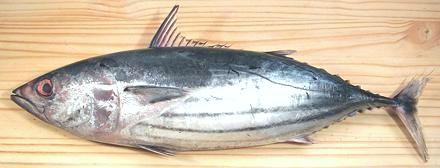 [Katsuo (sushi); Katsuwonus pelamis]
[Katsuo (sushi); Katsuwonus pelamis]
These small tuna can grow to over 43 inches and over 76 pounds, but the photo specimen was 18-1/2 inches and 3 pounds 13 ounces, about average in Southern California markets. Skipjack is found worldwide in tropical and warm-temperate seas but not in the Eastern Mediterranean or Black Sea. Photo © cg1.
Commercially Skipjack is sold fresh, frozen and canned, with a small amount sold smoked and dried. This fish is not considered endangered. IUCN Red List status NE (Not Evaluated). Monterey Bay Aquarium lists pole and troll taken as "Best Choice", purse seine and US Longline "Good Alternative" but imported longline as "Avoid". Now how you're supposed to tell how a frozen bonito in an Asian fish market was caught, I haven't a clue.
More on Varieties of Fish
(very large page).
Some sports fishermen say Bonito tastes like a "grilled football", and others say it's delicious. Clearly the difference is in how it's cooked. Bonito are very well regarded in regions that know how to cook fish, particularly Japan, Southeast Asia and Spain.
In all prep and cooking matters this fish is practically identical to the coastal Indo Pacific Bonito / Tongal Tuna (Euthynnus affinis). The flesh is dark red, darker than any beef, nor does it want to be served with white wine but rather a substantial red. The flesh is very tender raw but becomes quite firm when cooked. Use where fresh tuna is called for and you don't mind it being dark meat, or use in place of mackerel (it's a bit milder). Commercially, this fish is sold canned or frozen, and sometimes dried, salted and smoked.
Buying: This fish is usually available in the Asian markets here in Los Angeles and is quite economical, often selling for 2010 US $1.99/pound. If Skipjack isn't available Tongal probably is.
Scales: This fish has a few scales, up at the head end and supposedly by the dorsal fin though I've only found them near the head. Just these few are sufficient to make the fish kosher.
Cleaning: This is a very messy fish to clean - there will be blood, dark blood, and lots of it. Far more blood than you'd ever expect from a fish - have plenty of cold running water to rinse it away. The gill arches hold pretty hard so it's convenient to cut them away at the ends. The innards will need to be cut off at the head end as they don't pull out easily. The gills are very large but soft and cut out fairly easily with kitchen shears.
Fillet: Skipjack is not particularly difficult to fillet, except for all that blood. There are bones to follow, but you'll need to cut around the hard surround at the dorsal and anal fins. I first cut off the head - slant your knife strongly under the collar to get as much flesh as possible. When I get to the rib cage I cut the ribs from the backbone with kitchen shears and pull them from the fillet with long nose pliers, they rake back very sharply so need to be pulled out almost straight forward. There are lots of centerline pinbones that should be pulled, quite long at the very front but getting very short and soft as you work toward the tail. As you do, you'll notice prominent tendons - something you don't see in most fish. They can be left in.
Some instructions say to cut out the "blood line", the darker, stronger tasting flesh along the centerline - but if you do you won't have much fish left. If you don't like the strong flavor, use a different fish.
Skin: The skin has moderate shrink and blisters off the flesh, so it can be left on for pan frying, where it's relatively high oil content and stronger flavor are an asset rather than a liability. For other cooking methods it should be removed. It is relatively thick at the tail end and becomes very thick at the head end. It does not adhere well over most of the fish so it's not hard to remove using the usual long knife and cutting board Method. It is soft in the middle so the knife has to be held at as neutral an angle as can be managed without taking off significant flesh. Skin will remain on the skirt, it's thin and adheres very well there.
Yield: A 3 pound 13 ounce fish yielded 1 pound 15 ounces skin-off (51%). Counting the skirts it was 2 pounds 3/4 ounce (54%). The skirts are small and thin, and the lining membrane shrinks severely and unrelentingly, so I usually cut them off and toss them in the soup pieces bag in the freezer or just fry them up as a small snack.
Stock: The head, fins and bones, after initial ugliness, make a surprisingly clear and very fine soup stock. Bring to a boil in an open pot. As it comes to a boil there will be a lot of ugly reddish brown scum which you should skim off. Simmer for 1/2 hour, then strain and separate the oil using your gravy separator.
Health and Nutrition: There have been reports of ciguatera poisoning in tropical reef regions. Since it's a small tuna it doesn't pose a mercury hazard.
sf_skipz 2011 - www.clovegarden.com